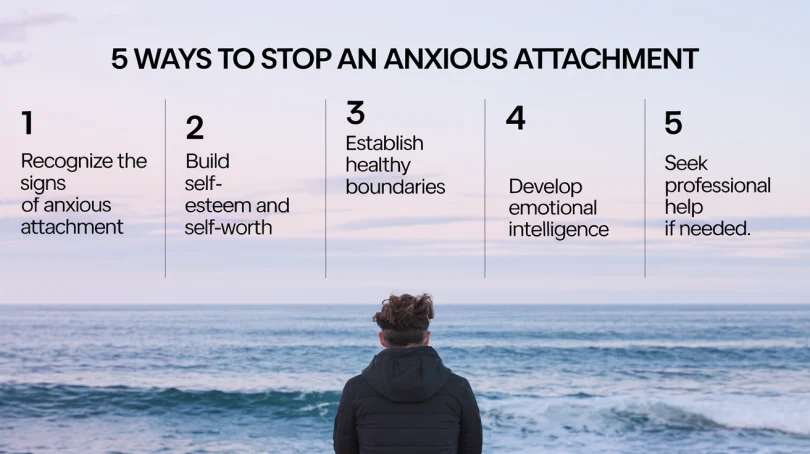Today, we’re talking about the five ways to better manage anxious attachment. Now, when I was doing research for this Topic, I spent a lot of time on Reddit looking for real-world examples like how it affects people and how it feels for them. During my research, I came across what I think is one of my favorite prompts. The prompt was: “What’s the most cringy thing you have done due to your anxious attachment?” You can understand my excitement!
My top two favorites (there were so many!) are:
Someone shared, “In my 20s, I jumped on the hood of my boyfriend’s truck to keep him from driving away.” Pretty good, right?
Another person said, “After we broke things off, I created a fake Instagram account of a bikini model that I knew he would like. I followed him, he followed me back, and I created posts just to get him to like them even though he had no idea they were mine.” And it gets worse! In the caption for one of the posts, I asked, “How do I look in this lingerie?” and he sent this fake, half-naked woman (aka me) a DM with a polite compliment. I was like, “I dated a man who sends DMs to half-naked Instagram models for attention.” That was cringey for me.
These stories show how anxious attachment can spiral into some pretty extreme behaviors. I’ll link this Reddit thread so you can follow along as we go through these five ways to better manage anxious attachment.
Before we dive in, I want to remind you what anxious attachment is. It often stems from childhood, where there was inconsistency in our parents or caregivers. This inconsistency left us unsure of what to expect whether they would show up, hurt us, or not. As a result, we grow up feeling insecure. In our adult relationships, this insecurity manifests as a fear of abandonment. We cling to people, fearing they might leave us or stop liking us. This fear is extremely painful and scary, which is why we hold on so tightly hence, anxious attachment.
Keep that in mind as we work through these tips because you’ll see how it applies to the examples I shared.
Tip #1: Build Self-Awareness
The first step is to build self-awareness. Let’s be honest many of us don’t even realize we’re spiraling until we’ve been spiraling for an entire day or week, and we’ve already taken action (like creating a fake Instagram account). We need to start recognizing when this is happening.
We have to get better at understanding the thoughts or bodily feelings we experience when we’re afraid someone is going to leave. If we’re triggered, we need to notice it before we take action.
As I was putting this video together, a friend reached out to me about someone she had just started dating. This is a perfect example of why self-awareness is so important.
This guy she was dating always hugged her when they first saw each other—even on their first date. But on their most recent date, he didn’t hug her right away. This sent her spiraling. She got in her car and thought, “Oh my God, he doesn’t like me. I’m getting rejected.” She even repeated her mantra: “Rejection is redirection.”
But here’s the thing: she’s been doing a lot of work in therapy, so she had the self-awareness to recognize that she was overreacting. She thought, “I’m just freaking out because rejection feels icky.” She didn’t take any action, and guess what? He asked her on another date! They’re on a date today playing pickleball.
If she hadn’t had that self-awareness, she could have canceled the next date, blocked him on the app, or sent him a bunch of texts like, “Are you sure you like me? Are you sure this is going well?” That awareness allowed her to avoid sabotaging a new, healthy relationship.
If this example resonates with you, know that having awareness gives us the space to make better choices. For example, if you notice yourself turning into Sherlock Holmes because someone didn’t text you back within an hour, being aware of that can help you make better decisions and improve your relationships.
Tip #2: Challenge Negative Thoughts
When we struggle with anxious attachment, we often jump to worst-case scenarios. For example, “They’re not texting me back because they’re over me,” or “That person hasn’t gotten back to me yet because they’re mad.” We need to challenge these negative thoughts.
Thoughts are not facts. So, pay attention to your awareness first: “Okay, I’m having these thoughts. Do I have facts to support them?”
Let me give you a personal example. Let’s say I went out with friends last night, and this morning I texted them, “So good to see you! Had such a great time. Can’t wait to see you again.” If they don’t get back to me for three or four hours, I might start spiraling: “What did I say? Did I say something mean? Maybe they don’t like me anymore.”
To challenge these thoughts, I need to check the facts. Did I say anything hurtful last night? No. Did we laugh together? Yes. When we were parting ways, they said, “So good to see you! We’ll have to do this again.”
By challenging our negative thoughts, we can prevent our anxious attachment from spiraling us out and pushing people away which is often what we fear the most.
Tip #3: Find Your Balance
When we have anxious attachments, we can make the person we care about the center of our world. We might turn down plans with friends, hoping they’ll call us. Then, if they don’t, we start feeling worse about ourselves and makeup stories like, “They hate me, and it’s over.”
To prevent this, we need to build a life we love. Say yes to invitations, spend time with friends, and do things you enjoy. Don’t put everything on one person.
For example, when I moved to Austin, I didn’t have many friends, and the ones I did know weren’t always available. I realized it wasn’t fair to put all my emotional well-being on one person or relationship. We have to build a life that’s fulfilling on its own, so when we bring someone into it, it’s just a bonus.
Tip #4: Learn to Communicate Your Needs Without Freaking Out
This one is hard but important. We often don’t want to seem needy, so we don’t ask for what we want. Then, we explode later.
A great tool I love is Brené Brown’s “The story I’m telling myself.” Instead of accusing someone, say, “The story I’m telling myself is that you don’t like me because you didn’t text me back.” This approach is less accusatory and opens up a dialogue.
Also, remember: unspoken expectations are resentments in the making. If something upsets you, communicate it. For example, “It’s very triggering for me when you don’t reply to my text within a day.”
Tip #5: Know When to Ask for Help
If these tips feel overwhelming or too hard to implement on your own, it’s okay to ask for help. Mental health professionals are there for a reason. They can help you check your facts, role-play conversations, and find better ways to interact.
Anxious attachment can turn us into someone we don’t even recognize like the kind of person who stalks LinkedIn profiles or creates fake Instagram accounts. If this feels too big to handle on your own, reach out for support. There are affordable therapy options, online support groups, and more.


